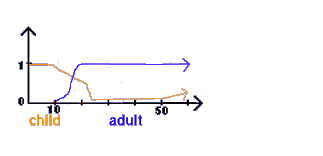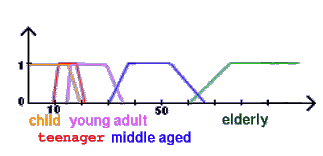




| |
Before, we looked at just one aspect of age; at what age you are a grown-up and at what age you are a non-grown-up. Of course, there are many different aspects of age, like if someone is old or not-old, at what age you turn from a baby to a non-baby, from when on and until when you are middle-aged, etc. All these are examples of different subsets of the set age.
 We can graph different subsets like the subsets of "Child" and "Adult" on the same graph.
Theoretically we could cram all the subsets of the set "Age" onto that same graph on the left. Of course
that would look ugly and we couldn't make much sense out of the graph anymore, so we usually limit ourselves
to a small number of subsets per graph.
We can graph different subsets like the subsets of "Child" and "Adult" on the same graph.
Theoretically we could cram all the subsets of the set "Age" onto that same graph on the left. Of course
that would look ugly and we couldn't make much sense out of the graph anymore, so we usually limit ourselves
to a small number of subsets per graph.
 Here's another graph showing a different selection of subsets. Again, these subsets are fuzzy subsets; there
is a gradual process from 0 (not-A) to 1 (A). This graph isn't very exact. We all know that being a teenager
isn't just like climbing up a slanted roof and sliding down the other side again. But since it is such a personal thing
how the curve would really have to look, it is easier to just agree on an abstract curve.
Here's another graph showing a different selection of subsets. Again, these subsets are fuzzy subsets; there
is a gradual process from 0 (not-A) to 1 (A). This graph isn't very exact. We all know that being a teenager
isn't just like climbing up a slanted roof and sliding down the other side again. But since it is such a personal thing
how the curve would really have to look, it is easier to just agree on an abstract curve.
